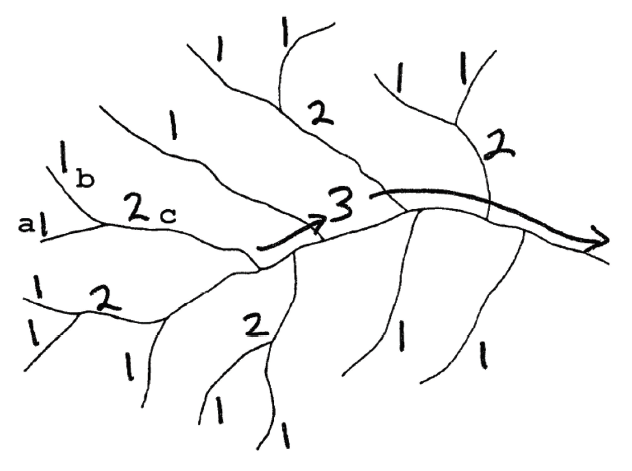The stream pattern within the drainage basin of Eds Creek on Map T-3 is reproduced at right at a smaller scale. On this small map, trace the length of all first-order streams with blue lines, the length of all second-order streams with red lines, and the length of Eds Creek (as a thirdorder stream) with a green line. If you don’t have colored pencils, number each segment as 1, 2, or 3.
The following questions are based on Map T-3, the “Deer Peak, Montana” quadrangle (scale 1:24,000; contour interval 40 feet), and Figure 39-3, a stereogram of the same area showing the drainage basin of Eds Creek (46°54'26"N, 114°31'02"W).
(a) How many first-order streams are shown?
(b) How many second-order streams are shown?

(a) 14
(b) 5
You might also like to view...
In a battery, the following oxidation-reduction reaction is taking place: Mn2O3 + ZnO ? 2 MnO2 + Zn What is undergoing reduction as written?
A. ZnO B. Zn C. MnO2 D. Mn2O3 E. none of the above
According to the National Oceanic and Atmospheric Association (NOAA), how much has Earth's average global average temperature risen since 1880?
A. 0.8° C (1.0° F) B. 0.8° C (1.4° F) C. 0.5° C (1.0° F) D. 1.0° C (33.8° F)
Motion of a P-wave is
A) side to side. B) transverse. C) longitudinal. D) up and down.
People with home septic systems often flush several cups of a powdered substance down their toilets every month or two to keep their systems healthy. These powdered substances most likely contain ________
A) chemicals that bind to heavy metals to keep them from leaching into the soil B) acids that help to clean the insides of the walls of the pipes and septic tank C) chlorine and other disinfectants that help to prevent soil contamination D) bacteria and enzymes that help break down wastes